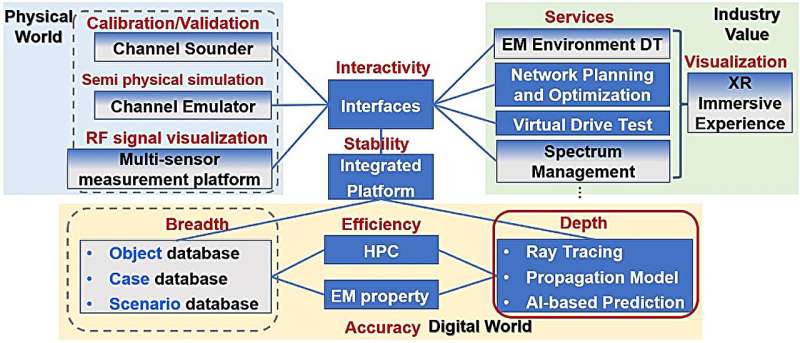
The railway system will continue to integrate global positioning systems (GPS), artificial intelligence (AI), and other technologies to improve safety, comfort, affordability, and eco-friendliness. This puts forward higher requirements for railway wireless communication networks.
As a digital counterpart of the virtual railway wireless network, digital twin (DT) can be used as a new paradigm for the construction, operation, and maintenance of the railway wireless network. However, the implementation of DT faces many challenges.
"Accurate and efficient modeling of radio wave propagation and wireless channel over a wide range of frequency bands is the primary challenge in achieving DT," explains Professor Ke Guan, lead author of a recent review published in High-speed Railway. "In this study, we summarized the key technologies to overcome the challenges, which are mainly divided into scenario modeling, radio wave propagation characterization, and integrated operation platform."
In terms of scenario modeling, three-dimensional (3D) automatic scenario reconstruction can be realized by using point cloud, grid dataset, satellite imaging, and oblique photography technology, and the cognition of scenario features can be realized by utilizing a deep neural network (DNN). The electromagnetic parameters of the materials in the scenario can be measured by the network parameter method.
For radio wave propagation characterization, the method of ray tracing (RT) technology has been introduced to achieve accurate deterministic modeling of wireless channels and introduce the environment discretization, visibility preprocessing, and geometry-based ray-trajectories derivation methods to deal with the problem of excessive computation.
In addition, AI-based super-resolution (SR) was combined with RT to generate a large amount of channel information based on a small amount of simulation dataset, further improving the simulation efficiency.
When it comes to integrated operation platforms, a high-performance RT simulation platform named CloudRT has been developed. It supports the simulation of various scenarios, frequency bands, and radio wave propagation mechanisms.
Based on the CloudRT, an integrated platform for wireless network planning and optimization has also been introduced, which supports the evaluation of existing deployment solutions and the planning of wireless network deployment solutions in specific scenarios.
More information: Ke Guan et al, Key technologies for wireless network digital twin towards smart railways, High-speed Railway (2024). DOI: 10.1016/j.hspr.2024.01.004
Provided by KeAi Communications Co.
Citation: Key technologies in digital twin of railway wireless network (2024, April 3) retrieved 3 April 2024 from https://techxplore.com/news/2024-04-key-technologies-digital-twin-railway.html
This document is subject to copyright. Apart from any fair dealing for the purpose of private study or research, no part may be reproduced without the written permission. The content is provided for information purposes only.
